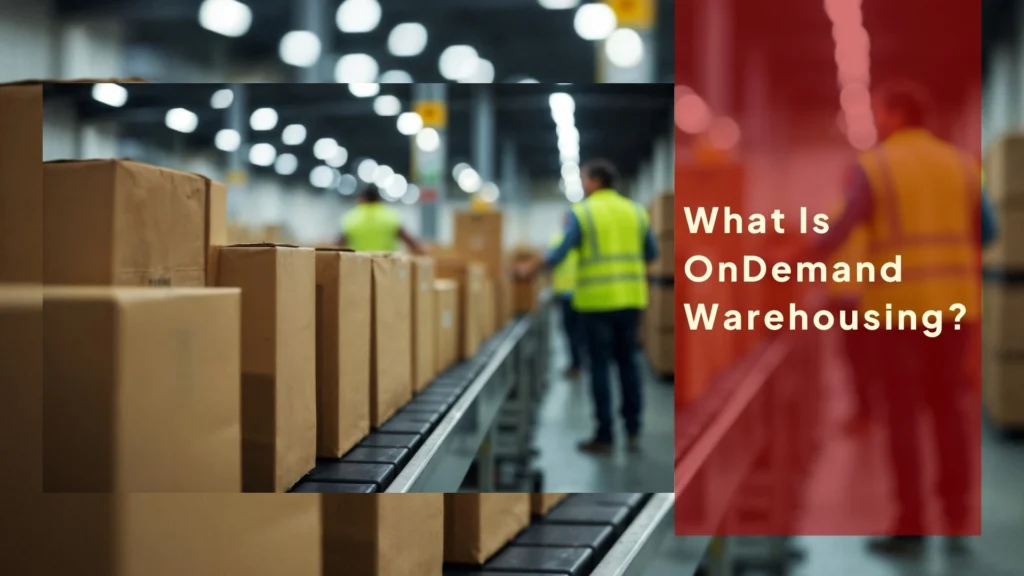The Indian e-commerce market is projected to reach a value of $325 billion by 2030. It is increasing at an alarming pace mainly because of the rise in online shoppers and the increase in internet usage in rural areas.
Most E-Commerce brands require flexible and scalable solutions for managing their products. This is where On-demand warehousing becomes important. It offers an approach that allows most businesses to adapt quickly to changes in market demands.
What Is OnDemand Warehousing?

On-demand warehousing is a flexible storage solution that allows businesses to rent warehouse space and fulfillment services when business is needed. It is a short-term requirement without long-term commitments. It is the best warehouse solution for companies to manage seasonal spikes, overflow inventory, or expansion into new markets.
There can be a sudden increase in orders during the festive season, which may be challenging for an e-commerce business to manage. Traditional warehousing requires long-term contracts, which may not be possible for many e-commerce businesses.
On-demand warehousing is an excellent option for businesses with fluctuating inventory requirements. It allows businesses to rent warehouse space and services only when they require it.
Let’s discuss this with an example. You run an e-commerce store and fulfill 5-10 customer orders daily. You can easily manage order fulfillment by keeping products in your storage.
But during the festive season, you get more orders from the customers. You don’t have much money to invest in building a warehouse. In such cases, the OnDemand warehouse is an excellent idea. You can store your inventories for a temporary period in the On-demand warehousing space. When the customer demand falls, you can store your products in the storage again.
Key Features of On-demand warehousing
1. Flexibility And Scalability
One of the most important features of OnDemand warehousing is its flexibility and scalability. A business can rent warehouse storage space according to its needs and requirements.
For example, you are running a small business and selling holiday-themed items. The order volume may spike during particular holidays, and hence, you will require additional space to store products. You can store them in the On-Demand warehouse to fulfill customer orders.
2. Cost Effectiveness
Traditional warehousing or outsourcing to a third-party logistics service provider requires a brand to pay money even for unused warehouse spaces.
But OnDemand warehousing requires brands to pay money only for the used spaces and services. This can be beneficial for small and medium business owners who experience order volume spikes in a particular season.
Various on-demand warehousing providers provide clear and transparent pricing models that allow brands to calculate and manage their expenditures.
3. Technology
Nowadays, the OnDemand warehousing space is leveraged with advanced technology. For example, real-time tracking can enable business owners to know about their inventories and storage conditions at all times. This enables business owners to improve their decision-making process.
There are even various on-demand warehousing platforms that seamlessly integrate with other systems, such as enterprise resource planning and order management systems. It enables a seamless information flow in the entire supply chain operations and improves efficiency by reducing errors.
Benefits of OnDemand warehouse

1. Fast Shipping And Fulfillment
Most e-commerce companies find it challenging to fulfill customer demands within a certain time frame, especially during the festive season or holidays. On-demand warehousing fulfills customer orders effectively and increases brand reputation in the market.
2. Technology
On Demand warehouses are equipped with advanced technology like data analytics, which increases visibility in the supply chain. They also offer demand analysis that predicts the product demand.
3. Expertise
A business may lack experience in international shipping or navigating customs regulations. On-demand warehouse Companies have a team of experienced and expert people who will ship products internationally with ease and enhance customer satisfaction.
4. Focus On Core Business
Traditional warehouses require a lot of time and resources to manage inventory effectively. For example, warehouse staff have to spend hours picking and packaging products. However, on-demand warehousing frees up time from managing inventories and allows staff to focus on core areas like product development or ways to explore new markets.
Challenges in On-Demand warehousing
1. Space Availability
The availability of on-demand warehouse space is always temporary. So, businesses should plan accordingly before storing their products in the warehouse.
2. Quality Control Issues
Bad inventory management is the next challenge of On-Demand warehousing. If the warehouse is messy or disorganized, then the inventories will not be managed properly. It can lead to late ecommerce fulfillment and badly affect customer satisfaction.
3. Limited Control
When a business stores its product in an on-demand warehouse, it has limited control over warehouse operations.

Conclusion
Every e-commerce company needs customized warehousing solutions to enhance customer satisfaction.
If you do not have sufficient warehouse space, especially when there is a surge in order volumes, then it’s best to utilize On-Demand warehouse space. They are flexible and cost-effective solutions for businesses of any size. There are a few challenges in an On-Demand Warehouse, like limited control and quality control issues. But the advantages outweigh the disadvantages.




